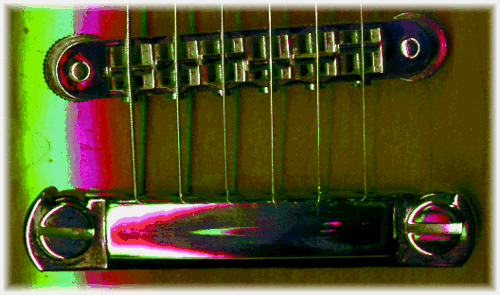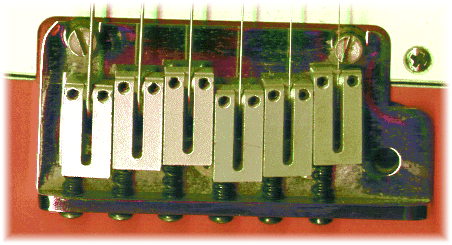|
Setting The Intonation
Excerpted from Guitar Set-up Tutorial If you want your guitar to play in tune all the way up the neck, you have to set the intonation correctly. this involves adjusting the "speaking" length of the strings - i'e' the distance between the nut and the bridge saddles. For this job you'll need some screwdrivers and an electronic tuner or some other sort of pitch reference such as pitch pipes. I'll cover the subject with regard to both Gibson Tune-O-Matic and Fender Tremelo bridges. Before I proceed, however, a couple of important points.

This bridge has six individually-adjustable saddles which are adjusted by means of the screws you can see at the bottom of the bridge facing the stop tailpiece. The screws are of the slot head variety. On some Gibsons these screws face the other way (usually on the older or replica models) and are slightly less accessible. Using a tuning reference, play a 12th fret harmonic on the bottom E string and then compare this with a note fretted at the 12th fret. The two notes should be exactly the same. If the fretted note is sharp, then the saddle needs to be moved back towards the tailpiece. If the fretted note is flat, the saddle needs to be moved the oppostite way - forwards towards the pick-ups. When the two notes are the same, the string has the correct intonation set. I find that the easiest way to remember all this is to think about flat and forward both beginning with the same letter. If you have to adjust the saddle, place a soft cloth below where you're going to insert the tip of the screwdriver to avoid scratches if the tip slips. Turn the screw clockwise to move the saddle back and anti-clockwise to move it forward. It's best to just make small turns, as a little turn can make a lot of difference. After every adjustment to the position of the saddle, retune the string to pitch and compare the 12th fret note with the harmonic. Repeat the operation until the string has the correct intonation. then move on to the next string.
If you look at both bridges, you can see that the saddles are both arranged similarly, with two offset rows of three saddles each. This is the sign of a well-set-up guitar and after a little practice, it is possible to set the saddles by eye to this arrangement and find that the guitar has almost perfect intonation! If you're buying a guitar it's a good sign to see this as it means that the instrument has been properly set up at some time or other. Don't do as one of my students did and move all the bridge saddles into a nice straight line! When do you need to set the intonation? Well, I always check the intonation whenever I change strings or I think that the intonation is suspect. Guitars are very susceptible to changes in temperature and humidity and this may cause some need for adjusting the intonation. If you keep your guitar in a case in an environment which has a constant temperature and use the same gauge and brand of string you may hardly ever need to adjust the intonation. It's a good idea to check it whenever you restring your guitar and this will reassure you that you'll be playing in tune, especially if you're stringing your guitar ready for a gig. Really, setting the intonation is very straightforward and there's no risk of damaging the bridge. Just work carefully and turn the saddle screws just a little bit at a time and just keep on checking the intonation until it's correct. |
